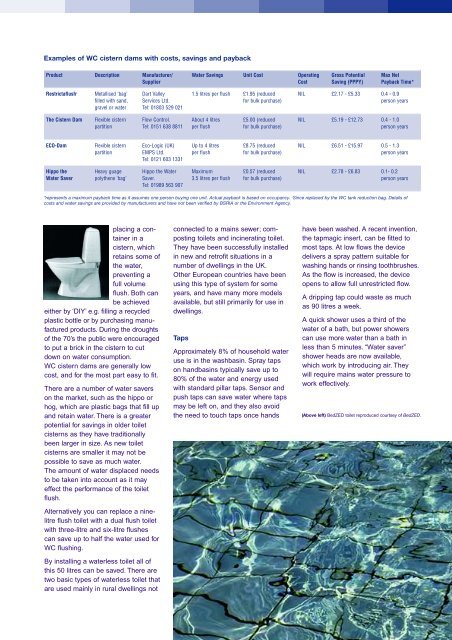improving and decorating your home
You also want an ePaper? Increase the reach of your titles
YUMPU automatically turns print PDFs into web optimized ePapers that Google loves.
Examples of WC cistern dams with costs, savings <strong>and</strong> payback<br />
Product Description Manufacturer/ Water Savings Unit Cost Operating Gross Potential Max Net<br />
Supplier Cost Saving (PPPY) Payback Time*<br />
Restrictaflush + Metallised ‘bag’ Dart Valley 1.5 litres per flush £1.95 (reduced NIL £2.17 - £5.33 0.4 - 0.9<br />
filled with s<strong>and</strong>, Services Ltd. for bulk purchase) person years<br />
gravel or water Tel: 01803 529 021<br />
The Cistern Dam Flexible cistern Flow Control. About 4 litres £5.00 (reduced NIL £5.19 - £12.73 0.4 - 1.0<br />
partition Tel: 0151 638 8811 per flush for bulk purchase) person years<br />
ECO-Dam Flexible cistern Eco-Logic (UK) Up to 4 litres £8.75 (reduced NIL £6.51 - £15.97 0.5 - 1.3<br />
partition EMPS Ltd. per flush for bulk purchase) person years<br />
Tel: 0121 603 1331<br />
Hippo the Heavy guage Hippo the Water Maximum £0.57 (reduced NIL £2.78 - £6.83 0.1- 0.2<br />
Water Saver polythene ‘bag’ Saver. 3.5 litres per flush for bulk purchase) person years<br />
Tel: 01989 563 907<br />
*represents a maximum payback time as it assumes one person buying one unit. Actual payback is based on occupancy. + Since replaced by the WC tank reduction bag. Details of<br />
costs <strong>and</strong> water savings are provided by manufacturers <strong>and</strong> have not been verified by BSRIA or the Environment Agency.<br />
placing a container<br />
in a<br />
cistern, which<br />
retains some of<br />
the water,<br />
preventing a<br />
full volume<br />
flush. Both can<br />
be achieved<br />
either by ‘DIY’ e.g. filling a recycled<br />
plastic bottle or by purchasing manufactured<br />
products. During the droughts<br />
of the 70’s the public were encouraged<br />
to put a brick in the cistern to cut<br />
down on water consumption.<br />
WC cistern dams are generally low<br />
cost, <strong>and</strong> for the most part easy to fit.<br />
There are a number of water savers<br />
on the market, such as the hippo or<br />
hog, which are plastic bags that fill up<br />
<strong>and</strong> retain water. There is a greater<br />
potential for savings in older toilet<br />
cisterns as they have traditionally<br />
been larger in size. As new toilet<br />
cisterns are smaller it may not be<br />
possible to save as much water.<br />
The amount of water displaced needs<br />
to be taken into account as it may<br />
effect the performance of the toilet<br />
flush.<br />
Alternatively you can replace a ninelitre<br />
flush toilet with a dual flush toilet<br />
with three-litre <strong>and</strong> six-litre flushes<br />
can save up to half the water used for<br />
WC flushing.<br />
By installing a waterless toilet all of<br />
this 50 litres can be saved. There are<br />
two basic types of waterless toilet that<br />
are used mainly in rural dwellings not<br />
connected to a mains sewer; composting<br />
toilets <strong>and</strong> incinerating toilet.<br />
They have been successfully installed<br />
in new <strong>and</strong> retrofit situations in a<br />
number of dwellings in the UK.<br />
Other European countries have been<br />
using this type of system for some<br />
years, <strong>and</strong> have many more models<br />
available, but still primarily for use in<br />
dwellings.<br />
Taps<br />
Approximately 8% of household water<br />
use is in the washbasin. Spray taps<br />
on h<strong>and</strong>basins typically save up to<br />
80% of the water <strong>and</strong> energy used<br />
with st<strong>and</strong>ard pillar taps. Sensor <strong>and</strong><br />
push taps can save water where taps<br />
may be left on, <strong>and</strong> they also avoid<br />
the need to touch taps once h<strong>and</strong>s<br />
have been washed. A recent invention,<br />
the tapmagic insert, can be fitted to<br />
most taps. At low flows the device<br />
delivers a spray pattern suitable for<br />
washing h<strong>and</strong>s or rinsing toothbrushes.<br />
As the flow is increased, the device<br />
opens to allow full unrestricted flow.<br />
A dripping tap could waste as much<br />
as 90 litres a week.<br />
A quick shower uses a third of the<br />
water of a bath, but power showers<br />
can use more water than a bath in<br />
less than 5 minutes. “Water saver”<br />
shower heads are now available,<br />
which work by introducing air. They<br />
will require mains water pressure to<br />
work effectively.<br />
(Above left) BedZED toilet reproduced courtsey of BedZED.



